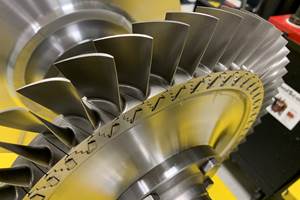Moving CAM To The Shop Floor
Conventional wisdom has it that CAD/CAM is something that happens in an office somewhere--indeed anywhere other than the shop floor. The notion of operators generating complex 3D tool path right there in the shop is simply not embraced by very many companies, and certainly not die and mold shops that must deal with themost challenging geometry on a daily basis.
Conventional wisdom has it that CAD/CAM is something that happens in an office somewhere--indeed anywhere other than the shop floor. A certain level of shop floor programming is tolerated with CNCs so equipped, or perhaps some simple G-code typed in at the operator's panel. But the notion of operators generating complex 3D tool path right there in the shop is simply not embraced by very many companies, and certainly not die and mold shops that must deal with the most challenging geometry on a daily basis.
An English CAD/CAM developer, Delcam International (Birmingham, U.K.), is out to change that notion, however, with a product concept that leaves the complex creation of geometry in the office, but puts the creation of tool path in the hands of those who understand the machining process best of all, those who practice machining on the shop floor.
If that name, Delcam, doesn't quite ring a bell, it's because the company has until recently kept a rather low profile in the U.S. It's a different story in Europe and other parts where the company's Duct5 CAD/CAM software is well regarded for its ability to deal with complex 3D geometry, which has made the system particularly applicable to die and mold makers. The company claims more than 3,000 users in over 40 countries, and current annual sales and services exceed $20 million. Delcam maintains its own job shop--making prototypes, molds, and precision parts--and thus has a working lab for practical development of their software.
That real-world experience was particularly advantageous in the development of PowerMill, the company's stand-alone CAM system. The basic concept of the product is to provide an easy-to-use yet robust tool just for creating tool path code. In operation, the idea is to pre-define all the necessary workpiece geometry in CAD, and then transfer that manufacturing-ready model to a CAM station where someone expert in machining practice can develop the part program.
The system makes it relatively easy for the programmer to work out a machining strategy, and to alter that strategy, or try out different options. In support of this sort of task, the system offers very fast calculation times for various tool movements. It also incorporates some interesting new program optimization tools. For instance, "silhouette machining" limits tool paths to the current outline of the workpiece so less time is spent cutting air. "Rest milling" restricts finishing cuts only to areas where material is known to remain from earlier operations. Finishing speeds can be improved by smoothing "join-up moves" at the ends of repetitive paths to avoid sudden changes in axis direction. Also, "projection finishing" allows machining paths to be projected toward or away from any point, line or plane, rather than simply running down a machine axis. This may be used to provide a more consistent step-over to improve surface finish, particularly when machining near vertical walls. And in all cases, the system offers very high-functioning gouge avoidance, taking into account the composite workpiece geometry, cutting tool and toolholder.
But it takes an experienced machinist to know how to make the most of these and other cutting strategies, which is precisely the point behind putting such a programming tool in the hands of people on the shop floor. Besides that, Delcam points out additional advantages, such as better utilization of human resources, both in the shop and in the CAD department. It also can lend a greater deal of flexibility as well as quality of work to both disciplines since each is freer to more fully apply their expertise at the moment it is required--if they have the appropriate tools for doing so.
But Delcam also cautions that moving CAM to the shop floor will take some time to become productive. It's a major cultural change for most shops, and more than a few human resources will have to be redirected in order to achieve a new equilibrium of people- and machine-power.--TLB
Related Content
Automated CAM Programming – Is Your Software Really Delivering?
A look at the latest automation tools in Autodesk Fusion 360 software and how forward-thinking machine shops and manufacturing departments are using them to slash delivery times and win more business.
Read MoreHow Integrated CAD/CAM Transforms Inventions Into Products
The close connection between CAD and CAM is what links creative ideas to practical production for this unique custom manufacturer.
Read MoreIntegrated CAD/CAM Promotes Process Efficiency, Traceability
High-requirement markets are not only searching for good parts — they're searching for proof of good parts. CAD/CAM software can help.
Read MoreImprove Machining Efficiency Through Digital Twin Simulation
Full simulation of a machining cycle using digital twins can not only identify crashes before they happen, but provide insights that enable the user to reduce cycle times.
Read MoreRead Next
The Cut Scene: The Finer Details of Large-Format Machining
Small details and features can have an outsized impact on large parts, such as Barbco’s collapsible utility drill head.
Read More3 Mistakes That Cause CNC Programs to Fail
Despite enhancements to manufacturing technology, there are still issues today that can cause programs to fail. These failures can cause lost time, scrapped parts, damaged machines and even injured operators.
Read More














.png;maxWidth=300;quality=90)

.png;maxWidth=300;quality=90)








